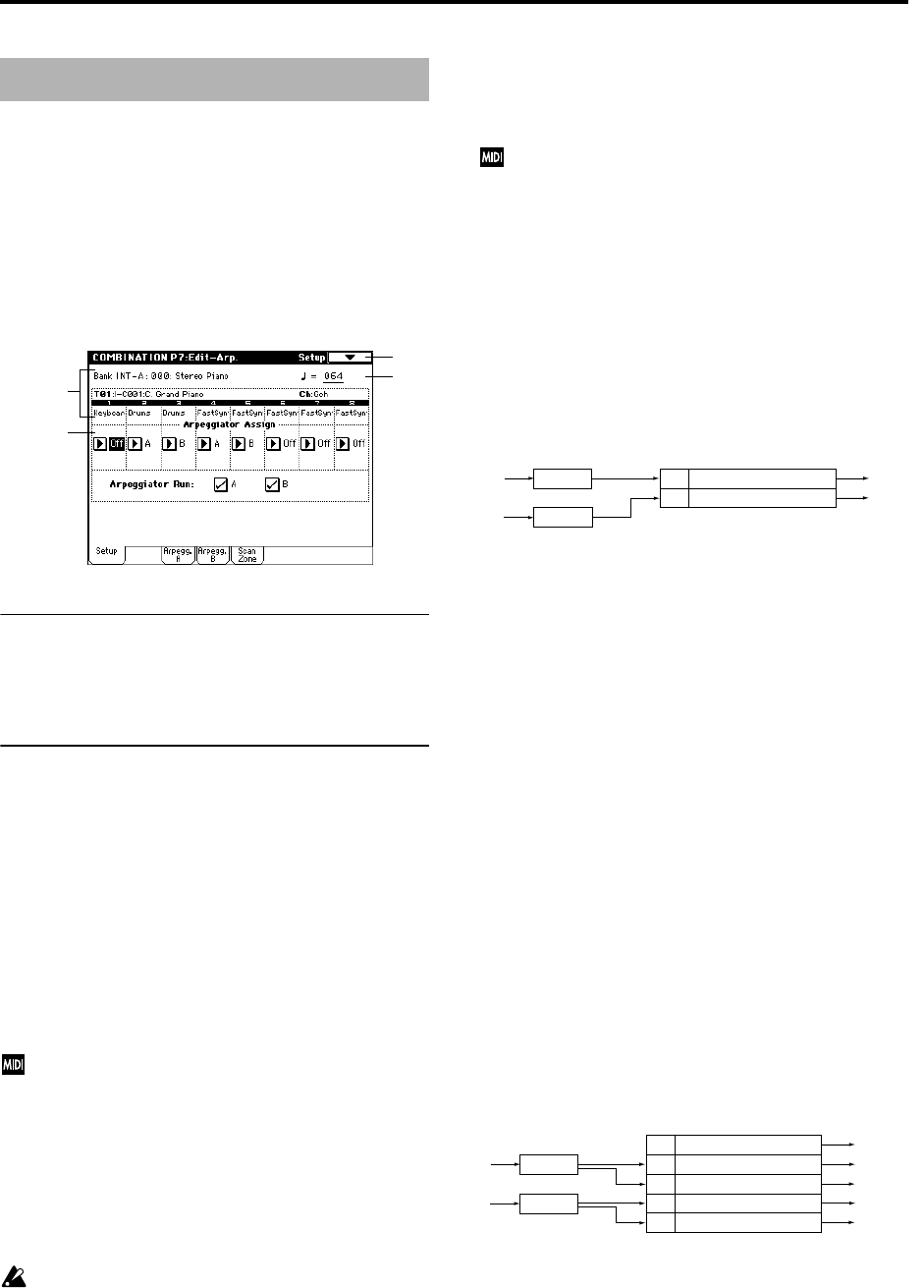
44
These parameters specify how the arpeggiator will function
within the combination. Two arpeggiators can run simulta-
neously.
This offers a variety of possibilities, such as applying sepa-
rate arpeggio patterns to two sounds that have been
assigned as a keyboard split, or using velocity to switch
between two arpeggio patterns.
7–1: Setup
7–1a: (Tempo) [040...240, EXT]
Specifies the tempo of the arpeggiator.
This can also be set by the [TEMPO] knob, or in the P0: Play
page. (☞0–1a)
7–1b: Arpeggiator Assign, Arpeggiator Run
Arpeggiator Assign [Off, A, B]
Assigns arpeggiator A or B to each timbre 1–8. When the
ARPEGGIATOR [ON/OFF] key is on, the arpeggiator speci-
fied for each timbre will operate according to “Arpeggiator
Run A, B” and these settings.
Off: The arpeggiator will not operate.
A: Arpeggiator A will operate. Use the settings in the Arpeg-
giator A page to select the arpeggio pattern and to set
parameters.
B: Arpeggiator B will operate. Use the settings in the Arpeg-
giator B page to select the arpeggio pattern and to set
parameters.
If the “Status” (0–1c, 2–1b) of the timbre is INT, each
timbre 1–8 will be sounded by the note data generated
by the assigned arpeggiator, regardless of the “MIDI
Channel” (2–1b) setting of the timbre. If a timbre is set
to EXT or EX2, MIDI note data will be transmitted on
the “MIDI Channel” of that timbre.
In this case, arpeggiator A (or B) will be triggered (oper-
ated) by all MIDI channels specified for the “MIDI
Channel” parameter of any timbre 1–8 assigned to
arpeggiator A or B.
If Local Control (“Local Control On,” Global P1: 1–1a) is
ON, the keyboard will not trigger the arpeggiator. The
arpeggiator will be triggered via MIDI IN. Turn Local
Control OFF if you have recorded only the trigger notes
on an external sequencer, and wish to playback the
external sequencer to trigger the TRITON STUDIO’s
arpeggiator.
If you want the note data generated by the arpeggiator
to be recorded on the external sequencer, turn Local
Control ON, and turn off the echo back function on
your external sequencer.
You can control the arpeggiator from an external
sequencer, or use an external sequencer to record arpeg-
gio note data. (☞p.266)
Example 1)
Set the “MIDI Channel” (2–1b) of timbres 1 and 2 to
Gch, and set “Status” (0–1c, 2–1b) to INT. Assign arpeg-
giator A to timbre 1 and arpeggiator B to timbre 2, and
check “Arpeggiator Run A, B” (0–3a, 7–1b).
• When the ARPEGGIATOR [ON/OFF] key is off, timbres
1 and 2 will sound simultaneously (layered) when you
play the keyboard.
• When the ARPEGGIATOR [ON/OFF] key is turned on,
timbre 1 will be played by arpeggiator A, and timbre 2
will be played by arpeggiator B.
Example 2)
The “MIDI Channel” (2–1b) of timbres 1, 2, 3, 4, and 5
are set respectively to Gch, Gch, 02, Gch, and 03. Their
“Status” (0–1c, 2–1b) is set respectively to INT, Off, INT,
Off, and INT. Assign arpeggiator A to timbres 2 and 3,
assign arpeggiator B to timbres 4 and 5, and check
“Arpeggiator Run A, B” (0–3a, 7–1b).
• When the ARPEGGIATOR [ON/OFF] key is off, playing
the keyboard will sound only timbre 1. (Timbres 2 and 4
are receiving the Gch, but they will not sound since their
“Status” is Off.)
• When you turn on the ARPEGGIATOR [ON/OFF] key,
arpeggiator A will operate for timbres 2 and 3, and
arpeggiator B will operate independently for timbres 4
and 5. (Arpeggiators A and B are triggered by receiving
note data on any MIDI channel of an assigned timbre,
but in this example they are being triggered from the
Gch.)
When you play the keyboard, arpeggiator A will operate
for timbres 2 and 3, but only timbre 3 whose “Status” is
INT will sound. Similarly, arpeggiator B will operate for
timbres 4 and 5, but only timbre 5 whose “Status” is INT
will sound.
In this way, you can make settings so that a timbre does
not sound when the arpeggiator is off, but sounds only
when the arpeggiator is on.
This type of setting is used in preloaded combinations
which sound the drums only when the arpeggiator is on.
Arpeggiator Run A, B
When the ARPEGGIATOR [ON/OFF] key is on, the arpeg-
giator(s) checked here will run if they are assigned to a tim-
bre by “Arpeggiator Assign” (7–1b). (☞0–3a)
Combination P7: Edit–Arp.
7–1
7–1a
7–1b
2–1a
Timbre 1 MIDI Ch=Gch Status=INT
Timbre 2 MIDI Ch=Gch Status=INT
Arpeggiator
A
Arpeggiator
B
Arpeggiator
Assign
A
B
Pattern - A
Pattern - B
Pattern - A
Pattern - B
Trigger
= Gch
Trigger
= Gch
Sounded by normal
keyboard playing
Pattern - B
Pattern - A
Timbre 2 MIDI Ch=Gch Status=Off
Timbre 3 MIDI Ch=2ch Status=INT
Arpeggiator
A
Arpeggiator
B
Arpeggiator
Assign
A
A
Pattern - A
Pattern - B
Trigger
= Gch, Ch2
Trigger
= Gch, Ch3
Timbre 4 MIDI Ch=Gch Status=Off
B
Timbre 5 MIDI Ch=3ch Status=INT
B
Off
Timbre 1 MIDI Ch=Gch Status=INT
Does not sound
Does not sound


















